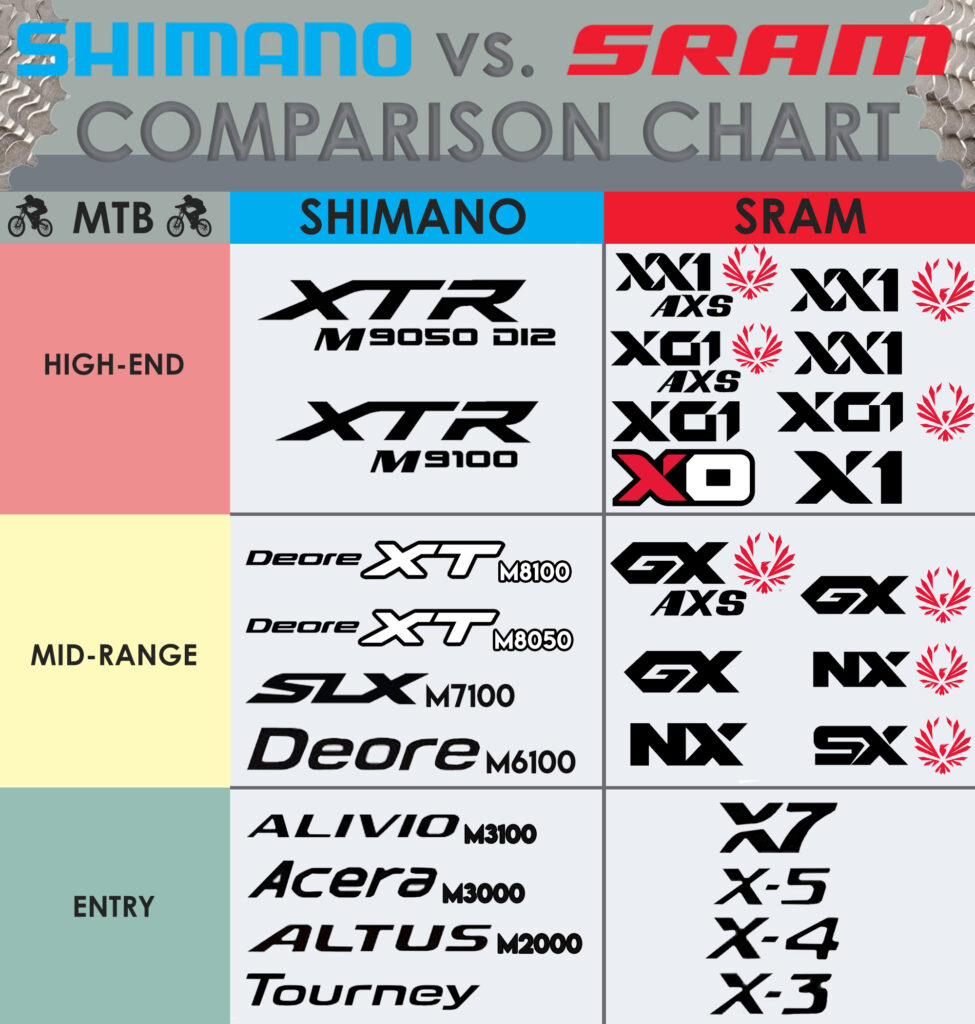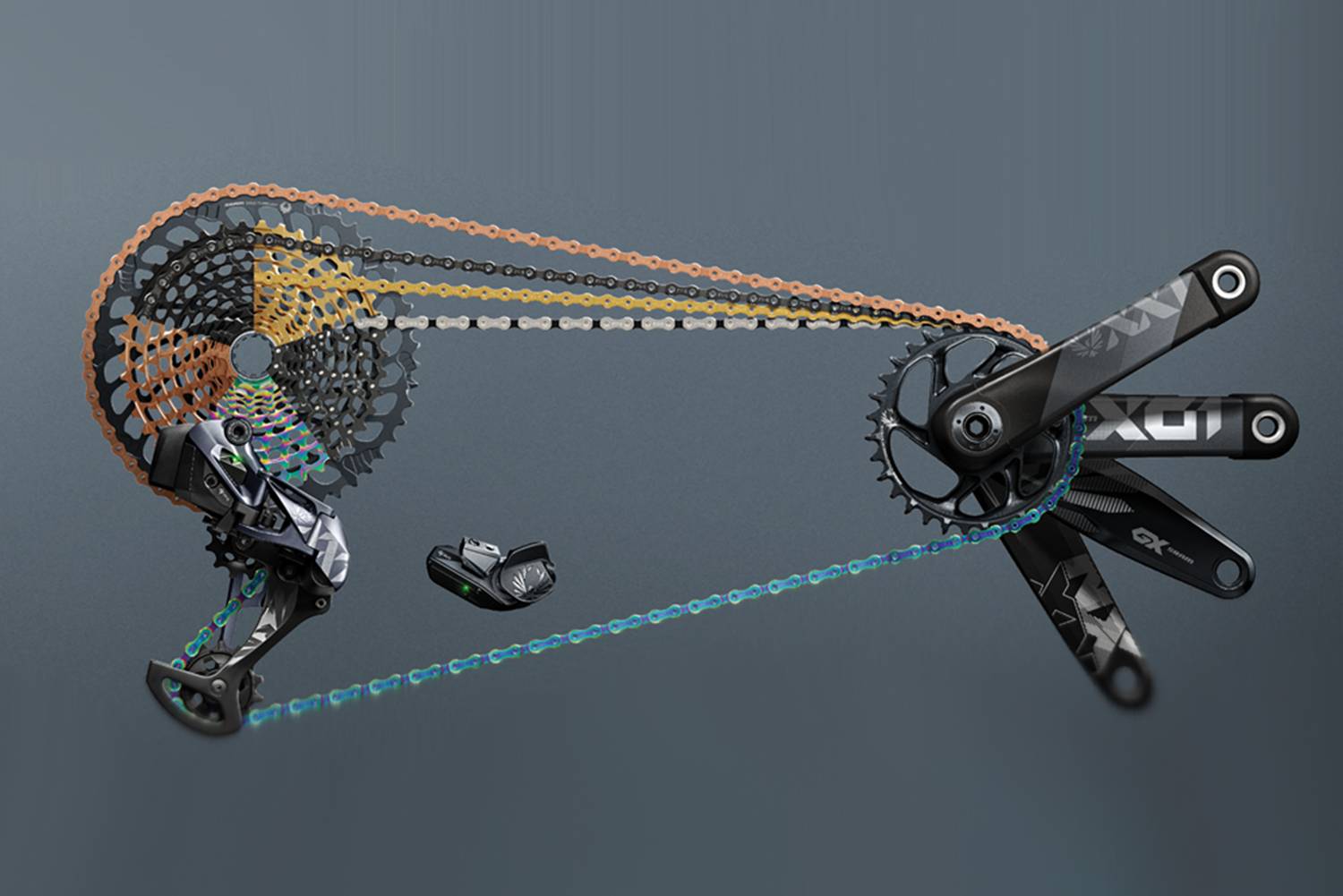Understanding the Importance of Groupset Selection
When it comes to mountain biking, the right groupset can make all the difference in your riding experience. A groupset is the collection of components that make up the drivetrain, brakes, and gears of your bike, and choosing the right one can significantly impact your performance, durability, and overall enjoyment on the trails. In the world of mountain biking, two brands stand out as leaders in groupset technology: SRAM and Shimano. The debate between SRAM vs Shimano MTB groupsets has been ongoing for years, with each brand offering unique features and benefits that cater to different riding styles and preferences. By understanding the importance of groupset selection, you can make an informed decision that will elevate your mountain biking experience and take your riding to the next level. Whether you’re a seasoned pro or just starting out, selecting the right groupset can be a game-changer, and it’s essential to consider factors such as terrain, riding style, and budget to ensure you’re getting the most out of your bike.
SRAM vs Shimano: A Brief History and Overview
SRAM and Shimano are two of the most recognizable names in the mountain bike industry, with a long history of innovation and competition. SRAM, founded in 1987, has been a pioneer in the development of mountain bike components, introducing the first dedicated mountain bike groupset in 1995. Shimano, founded in 1921, has a rich history in the cycling industry, with a focus on innovation and quality. In the mountain bike market, Shimano has been a dominant force, with its XTR and XT groupsets setting the standard for performance and durability. Today, both SRAM and Shimano offer a range of groupsets catering to different riding styles and budgets, with the SRAM vs Shimano MTB debate raging on among mountain bikers. Understanding the history and evolution of these two brands is essential in making an informed decision when choosing a groupset for your mountain bike.
How to Determine Your Groupset Needs: A Guide
Determining the right groupset for your mountain bike can be a daunting task, especially with the numerous options available from SRAM and Shimano. To make an informed decision, it’s essential to consider several factors that affect your riding experience. Here’s a step-by-step guide to help you determine your groupset needs:
1. Riding Style: Are you a cross-country enthusiast, an enduro rider, or a downhill specialist? Different riding styles require specific groupset features, such as gear ratios, brake systems, and cassette ranges.
2. Terrain: Will you be riding on smooth singletrack, technical trails, or rugged mountains? The terrain you ride on will influence your groupset choice, with factors like gear range, chainring size, and brake power coming into play.
3. Budget: Groupsets can range from affordable to very expensive. Set a budget and stick to it to ensure you get the best value for your money.
4. Component Compatibility: Ensure the groupset you choose is compatible with your bike’s frame, wheels, and other components.
5. Personal Preference: Consider your personal preferences, such as the feel of the shifters, the sound of the drivetrain, and the aesthetics of the components.
By considering these factors, you’ll be able to narrow down your options and choose a groupset that meets your specific needs. Whether you’re looking for a SRAM vs Shimano MTB groupset, understanding your requirements will help you make an informed decision and get the most out of your mountain bike.
SRAM Mountain Bike Groupsets: Features and Benefits
SRAM is a well-established brand in the mountain bike industry, known for its innovative and high-performance groupsets. Their mountain bike groupsets cater to a wide range of riding styles and budgets, offering a variety of features and benefits that set them apart from the competition.
1x and 2x Drivetrain Options: SRAM offers both 1x and 2x drivetrain options, providing riders with the flexibility to choose the setup that best suits their riding style. The 1x drivetrain is ideal for cross-country and trail riding, while the 2x drivetrain is better suited for enduro and downhill riding.
Brake Systems: SRAM’s brake systems are designed to provide exceptional stopping power and modulation. Their Guide and Code brake systems offer a range of features, including adjustable reach and contact point, to ensure a customized fit and feel.
Cassette Ranges: SRAM’s cassette ranges offer a wide range of gear options, from 10-50 teeth, to cater to different riding styles and terrain. Their Eagle cassette range, in particular, is designed for high-performance riding, offering a 500% gear range.
Other Features and Benefits: SRAM groupsets also offer a range of other features and benefits, including wireless shifting, customizable ergonomics, and a wide range of component compatibility. Their groupsets are designed to be durable, reliable, and easy to maintain, making them a popular choice among mountain bikers.
When considering a SRAM vs Shimano MTB groupset, it’s essential to weigh the features and benefits of each brand. By understanding the unique characteristics of SRAM groupsets, riders can make an informed decision and choose the best groupset for their mountain bike.
Shimano Mountain Bike Groupsets: Features and Benefits
Shimano is a legendary brand in the cycling industry, with a rich history of innovation and excellence. Their mountain bike groupsets are designed to provide exceptional performance, durability, and reliability, making them a popular choice among mountain bikers.
1x and 2x Drivetrain Options: Shimano offers both 1x and 2x drivetrain options, catering to different riding styles and preferences. Their 1x drivetrain is ideal for cross-country and trail riding, while their 2x drivetrain is better suited for enduro and downhill riding.
Brake Systems: Shimano’s brake systems are renowned for their exceptional stopping power and modulation. Their XTR and XT brake systems feature advanced technologies, such as Ice-Tech and Servo-Wave, to provide improved heat dissipation and brake control.
Cassette Ranges: Shimano’s cassette ranges offer a wide range of gear options, from 10-51 teeth, to cater to different riding styles and terrain. Their Micro-Shift technology ensures smooth and precise shifting, even under heavy load.
Other Features and Benefits: Shimano groupsets also offer a range of other features and benefits, including advanced ergonomics, customizable shift levers, and a wide range of component compatibility. Their groupsets are designed to be durable, reliable, and easy to maintain, making them a popular choice among mountain bikers.
When considering a SRAM vs Shimano MTB groupset, it’s essential to weigh the features and benefits of each brand. By understanding the unique characteristics of Shimano groupsets, riders can make an informed decision and choose the best groupset for their mountain bike.
Ultimately, the choice between SRAM and Shimano groupsets depends on individual preferences and riding styles. By understanding the features and benefits of each brand, riders can make an informed decision and choose the best groupset for their mountain bike, ensuring a superior riding experience.
SRAM vs Shimano: A Head-to-Head Comparison
When it comes to choosing the right groupset for your mountain bike, the debate between SRAM and Shimano is a crucial one. Both brands offer high-performance groupsets, but they differ in terms of design, features, and benefits. In this section, we’ll compare SRAM and Shimano groupsets side-by-side, highlighting their differences in terms of performance, durability, and price point.
Performance: Both SRAM and Shimano offer high-performance groupsets, but they differ in terms of shifting speed and accuracy. SRAM’s Eagle groupset is known for its lightning-fast shifting and precise gear changes, while Shimano’s XTR groupset offers smooth and consistent shifting. In terms of braking performance, Shimano’s XTR brake system is renowned for its exceptional stopping power and modulation, while SRAM’s Guide brake system offers improved heat dissipation and brake control.
Durability: Both SRAM and Shimano groupsets are designed to be durable and reliable, but they differ in terms of component design and materials. SRAM’s groupsets feature a more minimalist design, which can make them more prone to damage, while Shimano’s groupsets feature a more robust design, which can make them more durable. However, both brands offer high-quality components that are designed to withstand the rigors of mountain biking.
Price Point: SRAM and Shimano groupsets differ significantly in terms of price point. SRAM’s Eagle groupset is generally more expensive than Shimano’s XTR groupset, especially at the high end. However, both brands offer more affordable options, such as SRAM’s NX groupset and Shimano’s XT groupset, which offer similar performance at a lower price point.
Ultimately, the choice between SRAM and Shimano groupsets depends on individual preferences and riding styles. By understanding the differences between these two brands, riders can make an informed decision and choose the best groupset for their mountain bike. Whether you’re a cross-country rider or a downhill enthusiast, there’s a SRAM or Shimano groupset that’s right for you.
When considering a SRAM vs Shimano MTB groupset, it’s essential to weigh the pros and cons of each brand. By understanding the features and benefits of each brand, riders can make an informed decision and choose the best groupset for their mountain bike, ensuring a superior riding experience.
Real-World Performance: SRAM and Shimano in Action
When it comes to choosing the right groupset for your mountain bike, it’s essential to consider real-world performance. We spoke to several riders who have used both SRAM and Shimano groupsets to get their honest opinions on the two brands.
Rider 1: Cross-Country Enthusiast: “I’ve used both SRAM and Shimano groupsets for cross-country riding, and I have to say that SRAM’s Eagle groupset is my go-to choice. The shifting is lightning-fast, and the 1x drivetrain is perfect for my riding style. However, I’ve also had great experiences with Shimano’s XTR groupset, which offers exceptional braking performance and a more robust design.”
Rider 2: Downhill Specialist: “As a downhill rider, I need a groupset that can withstand the rigors of high-speed riding. Shimano’s Saint groupset has been my choice for years, and it’s never let me down. The braking performance is exceptional, and the 2x drivetrain provides the perfect range of gears for my riding style. That being said, I’ve also had the chance to try SRAM’s GX groupset, and it’s a close second in terms of performance and durability.”
Rider 3: Trail Rider: “I’ve used both SRAM and Shimano groupsets for trail riding, and I have to say that it’s a tough call. SRAM’s NX groupset is a great option for those on a budget, offering excellent performance at an affordable price point. However, Shimano’s XT groupset is also a great choice, offering a more robust design and exceptional braking performance. Ultimately, it comes down to personal preference and riding style.”
These real-world examples highlight the differences between SRAM and Shimano groupsets, but they also demonstrate that both brands offer high-performance options for mountain bikers. By considering the experiences of other riders, you can make an informed decision when choosing between SRAM and Shimano groupsets for your mountain bike.
When it comes to SRAM vs Shimano MTB groupsets, it’s essential to consider the needs of your ride. By understanding the features and benefits of each brand, you can make an informed decision and choose the best groupset for your mountain bike, ensuring a superior riding experience.
Making the Right Choice for Your Mountain Bike
When it comes to choosing the right groupset for your mountain bike, there are several factors to consider. By understanding the features and benefits of SRAM and Shimano groupsets, as well as their differences in terms of performance, durability, and price point, you can make an informed decision that meets your riding needs.
Remember to consider your riding style, terrain, and budget when selecting a groupset. Whether you’re a cross-country enthusiast, a downhill specialist, or a trail rider, there’s a SRAM or Shimano groupset that’s right for you.
When comparing SRAM vs Shimano MTB groupsets, it’s essential to weigh the pros and cons of each brand. By considering the experiences of other riders and understanding the features and benefits of each brand, you can make a decision that enhances your overall riding experience.
Ultimately, the right groupset for your mountain bike is one that meets your performance, durability, and budget needs. By following the guidance outlined in this article, you can make an informed decision and choose a groupset that takes your riding to the next level.
Whether you’re upgrading your current mountain bike or building a new one from scratch, the right groupset can make all the difference. By choosing between SRAM and Shimano groupsets with confidence, you can enjoy a superior riding experience and take your mountain biking to new heights.







